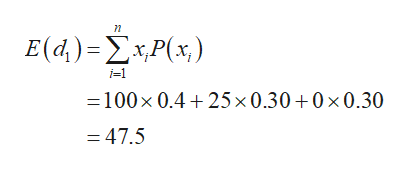#1. A firm has three investment alternatives. Pay offs are in thousands of dollars. Economic ConditionsDecision Alternatives Up, s1 Stable, s2 Down, S3Investment A, d1 100 25 0Investment B, d2 75 50 25Investment C, D3 50 50 50Probabilities 0.40 0.30 0.30a. What is the expected value of d1?b. What is the expected value of d2?c. What is the expected value of d3? Indifference Probability (p)Profit Decision Maker A Decision Maker B$75,000 0.80 0.60$50,000 0.60 0.30$25,000 0.30 0.15
Contingency Table
A contingency table can be defined as the visual representation of the relationship between two or more categorical variables that can be evaluated and registered. It is a categorical version of the scatterplot, which is used to investigate the linear relationship between two variables. A contingency table is indeed a type of frequency distribution table that displays two variables at the same time.
Binomial Distribution
Binomial is an algebraic expression of the sum or the difference of two terms. Before knowing about binomial distribution, we must know about the binomial theorem.
#1. A firm has three investment alternatives. Pay offs are in thousands of dollars.
Economic Conditions
Decision Alternatives Up, s1 Stable, s2 Down, S3
Investment A, d1 100 25 0
Investment B, d2 75 50 25
Investment C, D3 50 50 50
Probabilities 0.40 0.30 0.30
a. What is the
b. What is the expected value of d2?
c. What is the expected value of d3?
Indifference
Profit Decision Maker A Decision Maker B
$75,000 0.80 0.60
$50,000 0.60 0.30
$25,000 0.30 0.15
Given information:
The table of investment with the probability of Economic Conditions is given below.
Economic Conditions
Decision Alternatives Up, s1 Stable, s2 Down, S3
Investment A, d1 100 25 0
Investment B, d2 75 50 25
Investment C, D3 50 50 50
Probabilities 0.40 0.30 0.30
Let x is random variable.
The formula to calculated the expected value is,

a)
The expected value of d1 is calculated as follows:

Therefore, the expected value of d1 is 47.5.
Trending now
This is a popular solution!
Step by step
Solved in 8 steps with 4 images









